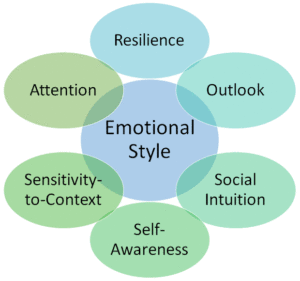I’m a regular patron of the Beaverton library. I usually work from a specific reading list based on recommendations from friends and colleagues. But I happen to browse the neuroscience section and came upon a title that caught my eye – The Emotional Life of Your Brain: How Its Unique Patterns Affect the Way You Think, Feel, and Live… and How You Can Change Them. Mmmm… a self-improvement guide for nerds!
It turns out that the author – Dr. Richard Davidson, PhD – was intrigued by the varying emotional responses that people manifest when dealing with all the things that life throws at them. As he entered graduate studies at Harvard in the 1970s, he wanted to establish a scientific basis for describing these variances while developing concrete methodologies that help people lead healthier, happier lives. His efforts helped birth affective neuroscience, the study of brain mechanisms that underlie our emotions.
 The book introduces readers to his six dimensions of “emotional style” along with a summary of the research that led to their development. You learn a bit about how the brain works and the differences that show up in varying manifestations of the six dimensions. He talks about the mind-body connection (a topic on which I’ve written previously). And he also talks about the ways in which our brains adapt and change based on the experiences we have and the thoughts that we think. I commend interested parties to read the book and dive into the details. It’s fascinating!
The book introduces readers to his six dimensions of “emotional style” along with a summary of the research that led to their development. You learn a bit about how the brain works and the differences that show up in varying manifestations of the six dimensions. He talks about the mind-body connection (a topic on which I’ve written previously). And he also talks about the ways in which our brains adapt and change based on the experiences we have and the thoughts that we think. I commend interested parties to read the book and dive into the details. It’s fascinating!
The six dimensions of “emotional style” for which Dr. Davidson found a clear neurological correlate are:
- Resilience measures the speed with which one shakes off the anger, sadness, or other negative emotion after a loss, setback, hassle, or other bothersome event. He labels the extremes Fast-to-Recover (insufficient reflection on, and learning from, an experience) and Slow-to-Recover (trapped in a cycle of excess rumination).
- Outlook reflects one’s attitude toward lived experience. One with a positive outlook sustains joyful, interconnected, outgoing, upbeat sensibilities. One with a negative outlook can experience positive sensations intermittently but is unable to keep them going.
- Socially intuitive people are adept at discerning and interpreting non-verbal communication, such as body language, facial expressions, vocal intonation, etc. They tend to exhibit high activation in the fusiform face area (which deciphers faces), and relatively low activation in the amygdala (which triggers the fight, flight, or freeze response).
- Self-Awareness provides consciousness of one’s thoughts and feelings; they’re mindful of the messages that their bodies are sending them. This capacity plays a crucial role in empathy for others. Those low in this capability may manifest emotions in their bodies (e.g., anger, stress) yet be completely unaware of them.
- People who exhibit Sensitivity-to-Context are attuned to their social environment and possess a keen awareness of the prevailing rules and expectations. Those who lack this ability are prone to inappropriate speech and behavior.
- People who rate high on the Attention scale can sustain focus even in the midst of a gaggle of distractions. They can zero in on a single conversation in a noisy party; they can forge ahead on projects and tasks in the midst of emotional turmoil. They’re also less susceptible to “attention blink,” a heightened response to a stimulus that causes “blindness” to a secondary one in close succession.
Prevailing wisdom suggested that “emotional styles” form early and stay with us throughout our lives. Dr. Davidson and his colleagues disproved this assertion. Sensory experience can rewire the brain. Thoughts and intentions increase or decrease the amount of cortical real estate dedicated to specific functions. And cognitive-behavioral therapy can alter brain activity in fundamental ways.
While Dr. Davidson does not place value judgments on one’s positioning on the six dimensions of emotional styles, he makes the case that certain patterns seem to be associated with better life outcomes and greater happiness. To that end, he practices meditation and encourages others to do so.
- Mindfulness-based stress reduction (MBSR) enhances left prefrontal cortex activation which has been associated with Fast-to-Recover resilience.
- An intensive period of mindfulness improves selective attention and reduces attentional blink.
- Compassion meditation has been shown to encourage a Positive Outlook.
Also included in his prescription for happier lives: Pay attention to positive characteristics in yourself and others. Express gratitude. Compliment others regularly.